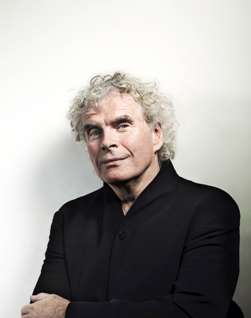|
Back
Song of the Night New York
Stern Auditorium, Carnegie Hall
11/09/2016 - & August 26 (Berlin), 28 (Salzburg), 30 (Luzern), September 2 (London), November 5 (Berlin), 11 (Boston), 12 (Ann Arbor), 15 (Toronto), 19 (Los Angeles), 23 (San Francisco), 2016
Pierre Boulez: Eclat
Gustav Mahler: Symphony No. 7 in E minor
Berliner Philharmoniker, Sir Simon Rattle (conductor)

S. Rattle (© Johann Sebastian Hanel)
"…like shadows passing us."
Gustav Mahler to Natalie Bauer-Lechner
The Symphony #7, uncharacteristically, came to Mahler in two lightning flashes of inspiration. Again he uses the five movement bridge structure but in a very different way from that of the fifth. In the Fifth the symphony is divided into two parts: the first three movements form one complete structure and the last three (with the third movement used in both) another (this blueprint was later employed by Béla Bartók for his String Quartet #2). In the Seventh, subtitled "The Song of the Night", Mahler links the first and fifth movements and fashions an internal framework out of the inner movements two, three and four. These three movements are all nocturnal ones and form the extended essay of memory within this complex construction. One glance at the movements’ names indicates this unusual architecture. The first and fifth movements have standard musical names (I. Langsam-Allegro con fuoco and V. Rondo-Finale) while the three inner movements are called II. Serenade (Nachtmusik I), III. Schattenhaft ("like a shadow"), and IV. Serenade (Nachtmusik II). He wrote the two serenades in 1904 and the other three movements in one amazing spurt of creative energy the following year.
Rather than laboring through many revisions, Mahler put the work away for three years and then rushed it into premiere in Prague in 1908, making changes in the orchestration right up to the evening of the performance with the help of several friends including, significantly, Alban Berg. This symphony is Mahler’s most complex work (an analysis of the amazingly rich last 49 measures of the first movement could be the subject for an extended essay) and the three inner movements are in many ways a complete work in themselves, a work that plays circularly with the image of memory.
Here we have Sir Simon again and the memory of his recent traversal of Mahler’s 6th at Carnegie Hall. Leading a different orchestra in his valedictory year, he retains Philadelphia as his “go-to” American band, even once promising to retire there. Before departing for the LSO he employs Berlin for some (hopefully) spectacular events this season.
What distinguishes a good performance from a great one? Over the years we have come to expect quite a lot from Simon Rattle and so judge him perhaps on a higher plane. Overall this was a fine effort but some of the subtleties were mangled just enough to raise concerns. In the first movement it was heartening that the opening solo was intoned by a tenorhorn as prescribed by Mahler in the score rather than the more mellifluous but totally out of balance euphonium employed by some modern conductors. It was satisfying to hear this correct choice, however the player totally destroying his first note was like fingernails on the blackboard.
Rattle sailed along nicely even as his forces were sometimes out of balance (for example, the two harpists might just as well have stayed out smoking on 56th street as their efforts were completely immersed in the overall orchestral glow). Then a bugbear of mine: Sir Simon observed the caesura in the score near the end of the movement, but did so skipping only a beat, as if he did not consider this electric moment the true fulcrum of the movement. The consequent ending was a bit sloppy.
On the plus side, maestro kept the strings in check during the Schattenhaft so that we could all enjoy the spectral wind and brass effects. However the fourth movement – perhaps my favorite in all of Mahler – was somewhat out of balance. The solo horn (so important to the narrative) was simply too soft in its duet with the mandolin but heart-meltingly beautiful when intoned against the lush background of the cello section. It was difficult to even hear the guitar and mandolin parts throughout the movement as they were subsumed by the entire orchestra. When he led the Philharmonic here in the 1970’s, Pierre Boulez used to sit the two gentlemen up in front of the ensemble where they would wait for a solid hour before playing their small but kaleidoscopically crucial parts in this second bit of Nachtmusik. Here Rattle drowned the pair and the signature morendo conclusion fell on deaf ears.
Eclat was composed by Boulez as a building block for future works. These later sequels were to be christened Eclat/Multiples and remained “unfinished” at least until Maestro’s demise. Sir Simon presented the original ur-text as a curtain raiser for the Mahler. One shadowy work preceding another.
Fred Kirshnit
|